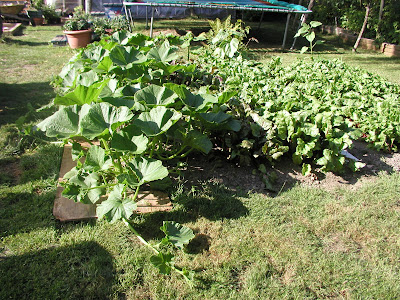Or let me shed tears of pride (and gratitude) reading over this:



No nonsense guide to winter gardening, with charts, times to do the planting, and so on; all of it geared towards growing in southern B.C. It is a product of civilization. I really like West Coast Seeds.
So yes, I have been starting the fall-to-winter garden. Today I planted rutabagas in this empty space at the back of one of the beds:
They are planted on the right side, with a small patch behind them planted with lettuce (the Paris Island Cos lettuce that I started in spring has been really satisfying). On the left (you can see how it's divided with the sticks) will go these leeks,
which were sarted from seed in the greenhouse in early spring. Leeks are very slow growing at first; but then after a certain stage, they grow rapidly. These will probably be harvested late fall. At least that's what I'm hoping. And I will be starting some more leeks (of the same winter variety called 'Bandit') tommorrow, which will be for late winter to spring harvest (overwintering), though for that harvest I am starting them just a weeny bit late (considering their initial slow growth); I'm sure they'll do fine.
August is for planting winter/spring onions (seeds). That is good because it will coincide with the harvesting of the potatoes and other vegetables, making the room I'll need for the winter gardening. It's nice how it works like that. I'll also be trying more carrots, more lettuce, beets ('Winter Keeper'), and of course more cabbage.
I'm also going to get a hold of garlic and horse radish. On top of this all I'm looking to grow for seed saving. Gardening doesn't seem like real gardening until you're attempting a winter garden. And in the meanwhile, the summer has just begun her gravid train.
*
I've made one discovery, after trying a number of times with different plants and seeds. Tin cans, with bottoms punched with holes, don't work very well at all.
Plants hate them. There's something about them that holds too much moisture and then they get way too hot when the sun hits them. It is unfortunate, because I thought it was going to be a great way of re-using all those tin cans we go through.
*
Here's some winter savoury I started from seed:
And some thyme:
The little guy in the tin can I found growing in the greenhouse when I was pulling up some weeds. I noticed a real nice fragrance all of a sudden and located it coming from this 'weed'. I have two of them planted now. It has to be some herb, but I don't know what kind.
*
The pole beans doing their thing:
The pumpkins, doing theirs,
together with the beets (three different varieties, and they obviously require thinning even though I've been thinning them) and the sunflowers, which are going to get a whole lot bigger than they are:
The Minnesota Midget Muskmelons (which yes, are not just little people who hail from Minnesota) are flowering in all that tangle:
All previous photos of beans, beets, pumpkins and muskmelons can be found here.
*
Here is a part of the front yard:
My Dad had been shaving the soil level down since it was too high, and the grass was only starting to reclaim its turf when I came along:
I'm sick in the head.
Same method of digging as found here. There are yellow bush beans and cucmbers started there (click on all photos to enlarge). The cukes might be a bit too lately started, but we'll see.
Next week on Garden Sprawl Fri--oh crap, did I forget to write about kiwifruit again?

3 comments:
Minnesota Midgets! You read my comment then :-)
I planted my fall tomato seedlings in the garden last weekend. I started them from seed and have been nursing them along. It seems crazy to plant anything when we have had 28 days of over 100 degrees (often as hot as 105) and it doesn't seem like it will be letting up soon. But they would have died anyway. So far a handful seem to be hanging in there. Starting a fall garden in Texas is very challenging because you have to get it started in the hottest time of the year. If it can actually last into the fall we can get a good harvest. The most difficult part is wanting to be out in the garden when it is 100 degrees.
Ukok,
Yes, I read every comment; and sometimes I don't respond to every one, not because of lack of appreciation, but because in my appreciation I smile and say a prayer for the person who wrote the comment and don't feel the need to always show it in words.
Jim,
I hope St. Swithun is turning his attention to Texas. It is strange for me to read the words 'fall' and 'tomato' as a compound. Besides definitely not being able to grow tomatoes once the middle of fall hits, here in British Columbia we are notorious for tomato late blight. Having one's seedlings die off is one kind of painful (which I hope does not happen to yours). But having your tomatoes all growing healthy and abundant with fruit, and then, just when they are starting to ripen...the blight can hit, and it's all for naught. Growing them under cover is pretty much a must here.
But also regarding starting a fall/winter garden during summer, we have a similiar challange here, sprouting seeds during the dry hot months.
Yes, I will concur, being out in the garden when it's 100...I'll take an all day siesta instead.
Send some of that heat up here. Though it's warm here, we could use a bit more. I'll send down some of our rain and sporadic coolness.
Post a Comment